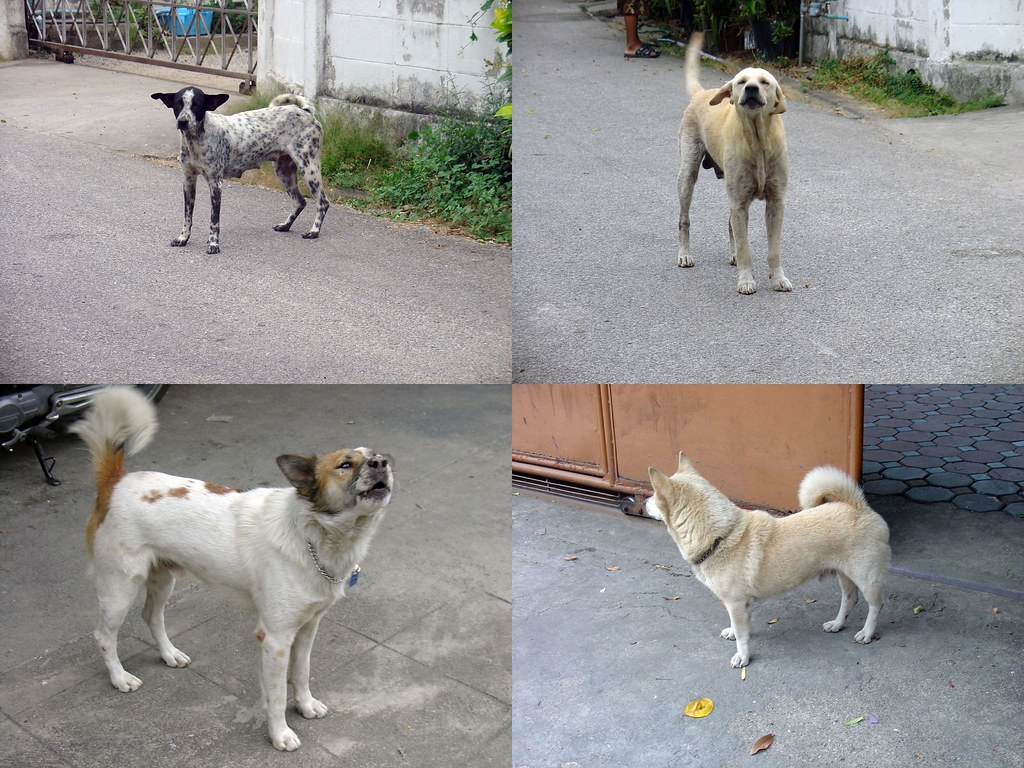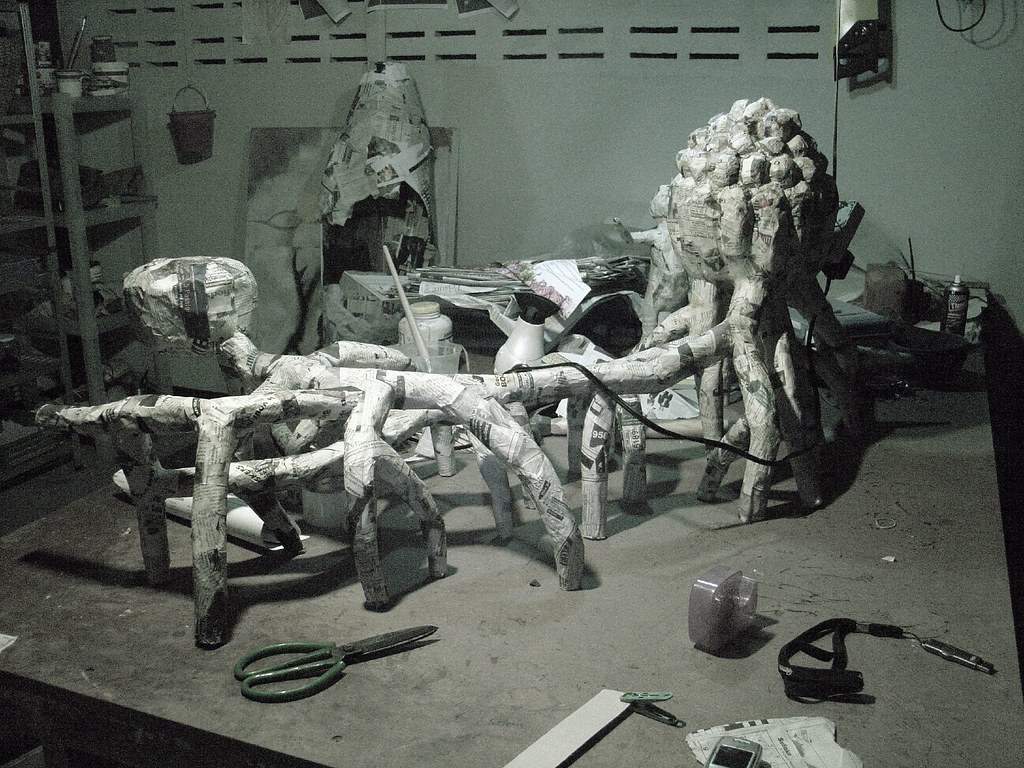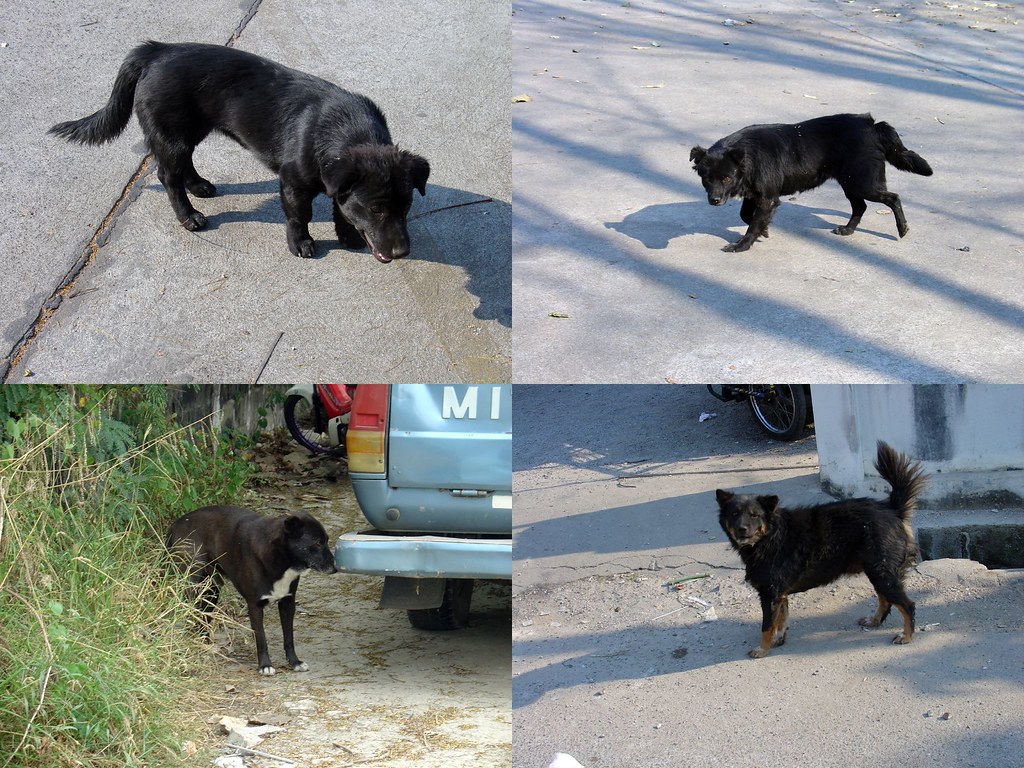21 December 2007
08 December 2007
05 December 2007
28 November 2007
24 November 2007
21 November 2007
One, Two, Three, Happy Thanksgiving

Posted by
Dane
at
10:28 PM
2
comments
![]()
20 November 2007
W Mouths

I don't know where this style of drawing mouths comes from, but a lot of Thai kids use it. I think it's just a mouth in profile, but oriented downwards. The result however, is a mouth that looks like something that is not a mouth...

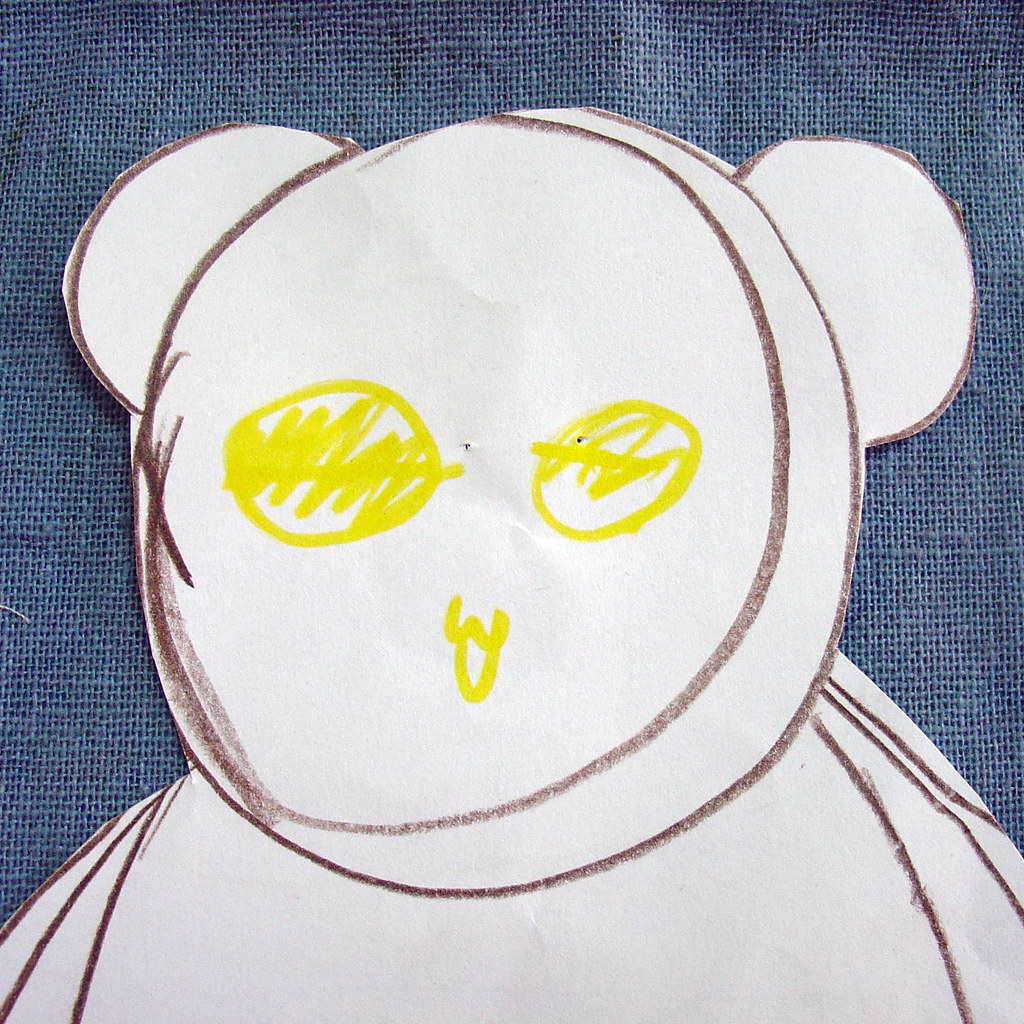
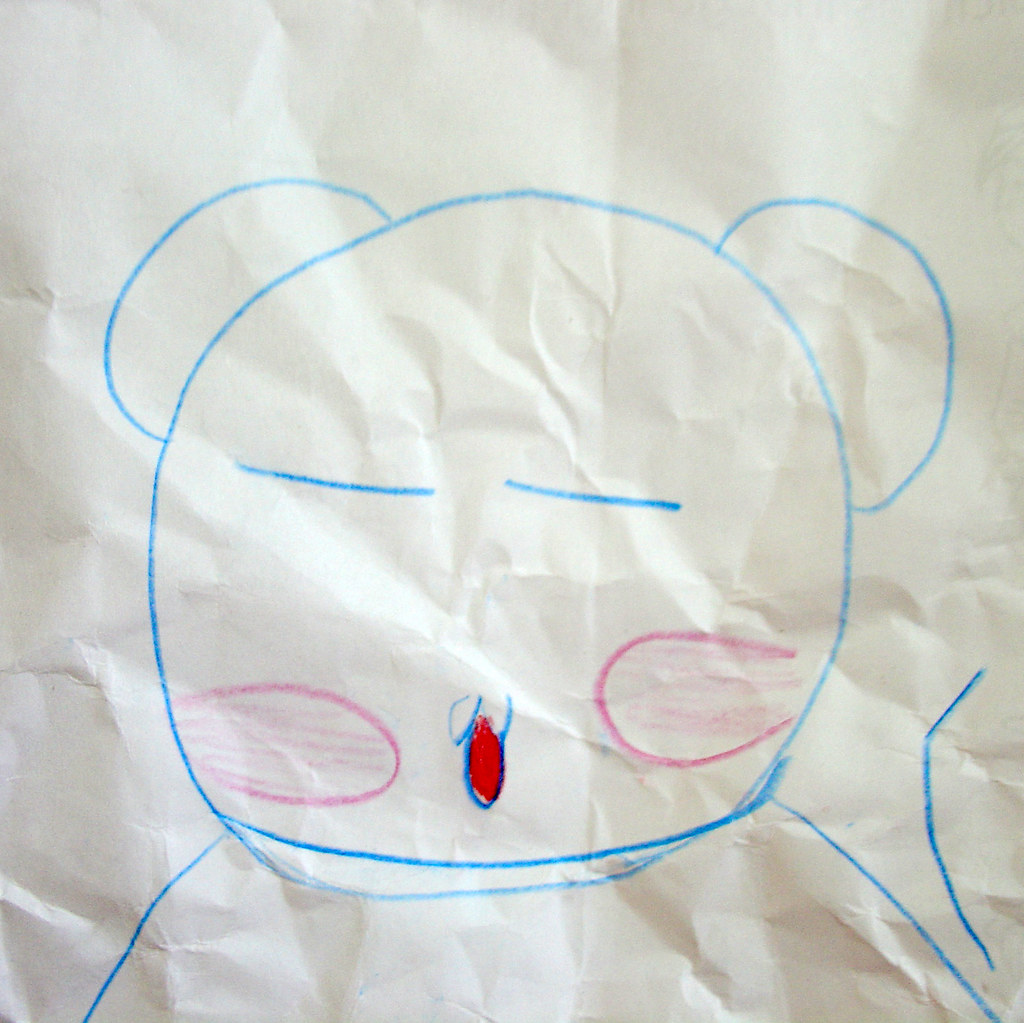
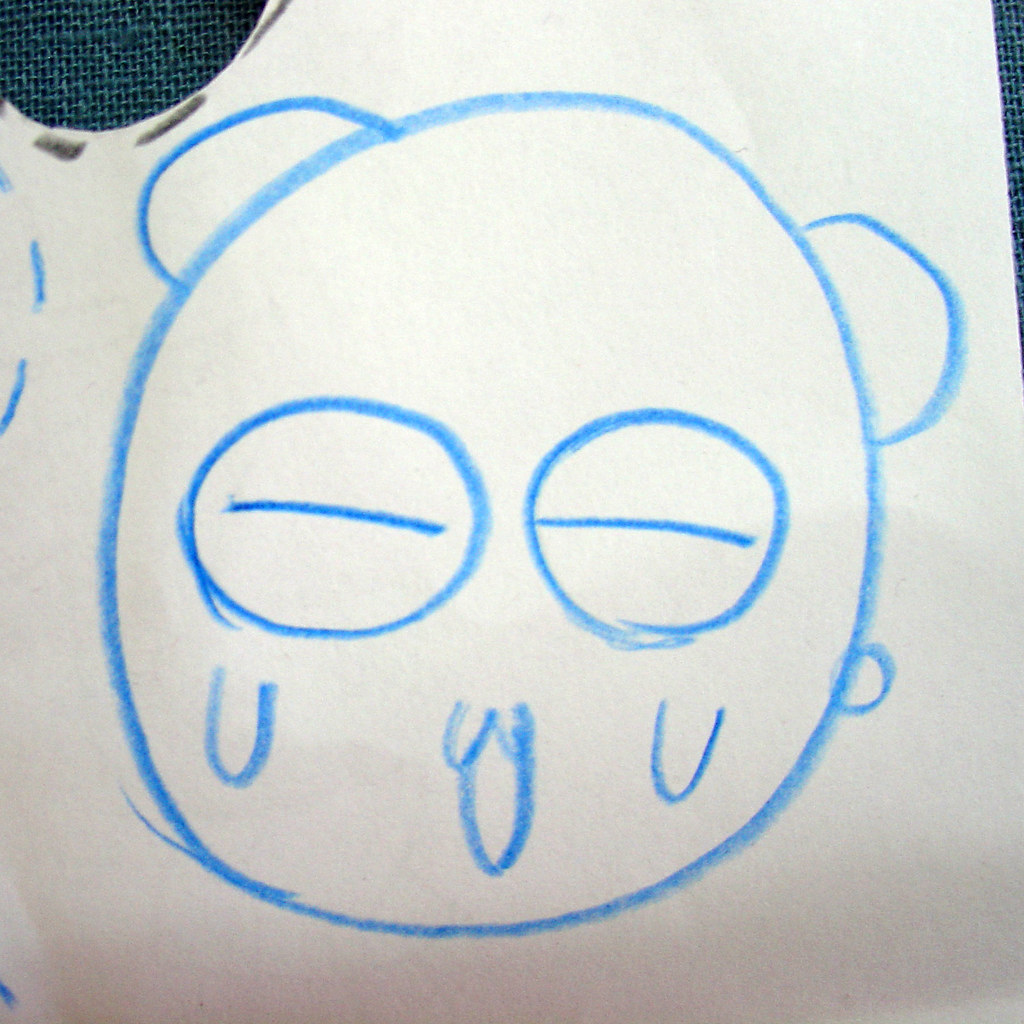

Posted by
Dane
at
10:34 PM
0
comments
![]()
17 November 2007
From the Truncated Files of Dane Larsen's iPod: An Interview with Brent Wilson
 This past July while traveling the east coast with my folks I sat down for an interview with my maternal grandfather Brent Wilson. My intention was to send the file off to the Mormon Stories podcast, since John Dehlin was at one time soliciting submissions. Unfortunately I had a bad mic connection, and every time I repositioned it hideous crackling resulted. The interview also lasted more than an hour, which podzilla seemed to take offense to, consequently truncating the file. About a week ago I decided to transcribe the interview for family history's sake, and was surprised at how much great material there was between the static.
This past July while traveling the east coast with my folks I sat down for an interview with my maternal grandfather Brent Wilson. My intention was to send the file off to the Mormon Stories podcast, since John Dehlin was at one time soliciting submissions. Unfortunately I had a bad mic connection, and every time I repositioned it hideous crackling resulted. The interview also lasted more than an hour, which podzilla seemed to take offense to, consequently truncating the file. About a week ago I decided to transcribe the interview for family history's sake, and was surprised at how much great material there was between the static.DL: Ok, this is Dane Larsen recording Brent Wilson, uh interviewing Brent Wilson. Brent Wilson is an artist, a lifelong artist and educator in the arts, and from a long line of LDS families, and continues to have a long line of LDS families extending from him. I am his grandson. And, well, Grandpa I'd like to start. Why don't you start talking about your, kind of the family's history in the church, briefly, to kind of explain where you come from, and then a little about your childhood and life in the church and also how art came to intersect that?
BW: Ok. Both my mother and my father's side are from [**static**] the Kirtland and Nauvoo periods so [******] joined the church, all of our ancestors very early on, and this means that they all crossed the plains. Interestingly a lot of geneology work has been done. Almost all of the work was started by your great great [great] grandmother, my great grandmother, Lerona Abigail Martin Wilson who started research on the french lines and as a matter [**************************************]
DL: [************] used that in a talk about three years ago, uh yeah, about two or three years ago [indistinct].
BW: Well...
DL: Is this the one where, I guess, her great grandfather appears to her?
BW: Well her, no, it was her father who appeared. He was Major Monroe. He had been in the Spanish-American, or Mexican-American War, and so he was a part of, I think an officer in the Weber County Militia. So he came back in full military dress and commanded Lerona to start working on the French lines, introduced her to, in vision, in a vision, to lots of our deceased ancestors and lots of other French people and said they're all waiting for our work to be done. He said, it doesn't matter if they're members of our family or not, just gather the names and the vital statistics. And she was instructed to go to the temple president and they actually got permission to do the temple work for not just our French ancestors but also for all the French people who were not members of the family. This was permission I think the temple president went to the general authorities and got permission. And this was in...
DL: And these were names she actually got from dreams?
BW: Um yeah, well a dream or a vision. She called them visions.
DL: Yeah.
BW: And so this was the extraction program fifty years before it became a church wide program. So this was, that's one example of many dedicated and faithful members of the church, and both sides of my family, both my mother and my father's ancestors... So I grew up in Cache Valley, in Fairview Idaho, just north of the Utah Line. And I jokingly say that I would have loved to have gone to an art museum when I was a kid, but the closest one was in San Francisco, about 800 miles away. Now, I'm not sure that that's actually true, but I really don't know whether there was an art museum at the University of Utah. Certainly there wasn't at Utah State because Utah State was twenty miles down the road. So there were some paintings in the library of my high-school, Preston High-School, but to have access to original works of art was virtually impossible. But I did encounter artworks in Life Magazine. In 1950 when I was sixteen years old my aunt Mildred gave me permission to go through all of her Life Magazines that she had saved in her basement, going back to 1939, and I tore out every article on art. And it was quite a marvelous education in art, because there were traditional works; I remember the fold out spread of the Sistine Chapel ceiling by Michelangelo, but also things like Andrew Wyeth's work. There was a piece, An Artist Paints a Ghostly House. So, I remember quite vividly the Abstract Expressionists who had organized themselves to protest the fact that the Metropolitan Museum was not supporting contemporary or modern art. And so Life Magazine, even though it often poked fun at contemporary painters, I think they probably did call Jackson Pollock "Jack the Dripper," but it didn't matter because they were presenting contemporary artists' works. So that was my initial education in art, and then...
DL: When, how did you become interested in art in the first place?
BW: Well that's, oh, I think one starts out enjoying the act of drawing. I remember in first grade the kids, my classmates, would come to me and ask me to draw dogs for them. Now I don't think I drew dogs any better than they did, except I was willing to draw them, and because they asked me to draw them I thought, oh, I must be pretty good. I don't think I was, but I obviously had an interest in drawing things, and then getting a little bit of reenforcement. I think many kids think of themselves as artists because so many young kids enjoy drawing. So that was the beginning, and then I remember that I had an uncle, my father's oldest brother, who, during World War II when he was working in Hawaii, did some oil paintings. He was an amateur and only did a few of them. But I remember saying, wow I could do something like that. So anything having to with art fascinated me. And I dug clay out of the ground. Cache Valley has a layer of clay that's only about two and half feet down, deposited in lake Bonneville.
DL: I remember Great Grandma telling that story of you digging on the side of the house.
BW: Oh, I would dig holes all over to get my stock of clay, and then I would fire it in her oven and she wouldn't care much for that, and so I would put it in a bucket with a bonfire around it, anything to get it fired. So, it was a lot of things of that sort. Um, and so when I entered high-school, the second year, I took an art class. My art teacher Lyle Shipley was interesting. He was the music teacher, and they needed an art teacher, and Shipley's wife had majored in art in college. And I really think that she made the suggestions of what he should present, the kinds of assignments he should give, and so on.
DL: But he taught the class?
BW: But he taught the class, and because he didn't have fixed ideas about art, and what it should be, and what the students should be working on... I've just written about this. In 1950 I traveled east for the first time, I'm sixteen years old, with the Boy Scouts to go to the National Jamboree in Valley Forge. And we stopped in New York City and did the usual things, like go to Conney Island, taking the Circle Line Tour around Manhattan, and going to a Yankee's game. And the night before we were to leave for Washington D.C. and go on to Valley Forge, I was walking up 53rd street, looked up, I remember it was dusk, and I remember it vividly, and there was the marquee for the Museum of Modern Art. I said, dang I could have gone there, if I had known it was there, because we were staying at the Taft Hotel, so it was in that neighborhood. Well with this idea that there's art in this town, in New York City, I was on my way back from breakfast the next morning, and I saw an art book, and it was Emily Genauer's The Best of Art. And as a matter of fact, let me run over and get it.
DL: Grab it. I should mention while he's looking for that, that we are now overlooking the Tapanzee Bridge, and my Grandpa's course through life has led him to within about fifteen miles of New York City, but we're in Nyack, so he still gets to be in a small town.
BW: OK here is Emily Genauer's Best of Art. So, I spotted this book in a, it was a variety store, not a book store. I went in, it was the first art book on contemporary art I had seen. I think already I had purchased Ernst Gombrich's The Story of Art. So I went in, so, I wanna buy this book, uh, that book. And the clerk looked around and said, we don't have one. And I said, yes you do, there's one in the window. So she called the manger who went in [**************************the manager gets his shirt dirty crawling into the display window*************************] on the way to the National Jamboree. Emily Genauer was perhaps the first critic, she wrote, was the critic for the, oh what was it, the New York World in the 1930's when she began to write about artists such as Marc Chagall and Diego Rivera, and won a Pulitzer prize for her critical writing. Well I picked a good book. So what she did, she had reviewed exhibitions, the art exhibitions throughout the United States in 1948, and selected fifty works. Among them were paintings by Stewart Davis, and I'm flipping to find that page, and I'm afraid that we won't turn to it, but... Well here we go. Here's Stewart Davis and the painting For Internal Use Only. It's really ah...
DL: It's a nice one.
BW: It's really one of the best paintings I think. But also, here's George Groze, in here we find Philip Guston, during his...
DL: What was Philip Guston doing in '48?
BW: Well, he was doing cubist-like paintings, but uh...
DL: I haven't even seen his cubist stuff.
BW: ...where do we find, there's Marc Chagall, but where is Guston?
DL: I think it was right before...
BW: But here's Matta, which is really quite an amazing painting. Well Guston, here, here is Philip Guston, and as I said it was a sort of his cubist phase [******************************************************************************************************************************************] but that's [*************************************************************************] and the [************************************************] which was light and airy, with bay windows, and I began to work in the style of these painters. So, this painter who's, is it Hans Miller? Yes. I don't know his work well, but he was doing a curious kind of way of...
DL: Very linear, and flat colors...
BW: Yeah, figures. So he does chess players. So did I do? I think I did boxers, but, you know, I would pick up on two figures and hit the way of using lines, and color inside the lines. But there were other paintings, like Yves Tanguey, where there was a school play, and they needed a modern painting in the play, so the drama teacher asked me if I would paint a painting for them. I copied this painting as carefully as I could, and the elegant, smooth handling of the paint. I remember using my fingers to blend the paint, the white and the gray. And so, after the play was over the drama teacher bought the painting from me for five dollars. So I knew I was really good by then.
DL: [laughing] Right, who wouldn't?
BW: So, now it was interesting that when I won art contests at Preston high-school, and the contests were judged by professors at Utah State. So Calvin Fletcher, Jesse Larsen, Eb Thorpe were three of them who came to Preston High-School. So I became acquainted with the professors of Utah State before I went there. And I didn't think of going any other place, but just twenty miles down the road to Utah State, which, interestingly, at the time, had the most contemporary art department in Utah. And Calvin Fletcher had been to France in the early part of the century, I think it may have been around, you know, but surely before the 1920s, and carried ideas about Cubism back. And, interestingly, even late in his career he was doing works that were, some works that were influenced by Cubism. So these people became my teachers. But I remember that in the first painting critique, this was during my freshman year, one of the comments was, Wilson's work doesn't look like the rest of ours. And I thought to myself, yeah, 'cause I know things that you don't know. And it was stuff coming from The Best of Art and from Life Magazine. It was, I've always drawn on sources.
DL: I'm curious, what was, I mean what was expected of an LDS artist at that time, I mean...
BW: Well...
DL: ...granted it's, it's in the middle of the country, it's very provincial, and, so you're the only one looking at this, what was everybody else expected to be doing?
BW: Well, there was only one event, one time when I remember one of my professors talking about LDS art, and the possibility of drawing on LDS or Mormon culture as subject matter for one's works. Now I remember that Floyd Carlby who was head of the art department for a time at Utah State did a painting of the temple in a sort of a Cubist style. Ah, so, but that, that was about all is was. Well, I should say that Eb Thorpe got commissioned to do murals having to do with pioneer subject matter, and he was basically a realist painter, did a lot of portrait painting, especially several portraits, as I remember, of David O McKay. But because I needed to work it made it difficult for me to attend painting classes. So my professors, by this time Harrison Gratitch had accepted a position at Utah State, and this was probably during my junior year, and I made arrangements to sign up for a class, but to do independent study, in effect, to work on my own. So I made myself a studio underneath the ceramics studio. The ceramics studio was in an old heating plant outside of Old Main. It was no longer used as a heating plant, but all of the old pipes and tunnels for the heat were still underneath it. And here was the clay dust sifting down to my sort of stairwell area studio. It was concrete and clattery pipes. But I was the only one, faculty or student at Utah State who had my own private studio, because I was willing to work in this disgusting clay place. So Harrison Gratitch came down, and he was looking at the work that I was doing. And I was doing a lot of things like, just realistic things that would capture my attention. I remember I had taken a photograph of a kind of warehouse in Bellingham, Washington. This would have been in 1955, [coughs] excuse me, and it had a marvelous circus poster on it. So I put a couple of little kids in front of the circus poster, and the poster's sort of torn and so on. For me it was a kind of striking image. And so this is the kind of thing I was painting [coughs]. My voice is going to go.
DL: Do you want some water real quick? Or do you wanna quit?
BW: Well let's tell a story. Maybe a swallow of water will help. I hope. You can edit this tape I hope.
DL: Yeah I can.
BW: [chuckles] Ah, thank you. So Gratitch had looked at the paintings. And, you know, with any student you expect to be drawn to any number of styles. I was playing with Surrealism, I was doing paintings that were reminiscent of Easter Island heads, and I was doing paintings of chinese ceramic figures, but, y'know abstracting them. But drawing all kinds of sources, things I encountered every day.
DL: And you're a senior?
BW: Well, yes. This was the beginning of my senior year, because I went to Washington in 1955, and that's when I would have taken the photograph. And I was working with Magma, the new plastic paint. And I remember that here were my paintings that were being covered by dust. And rather than washing them off I just took a spray of varnish to them, so these paintings, wherever they are, oh they're the ones that Dan Riplinger has, have...
DL: I've seen a couple of them, yeah.
BW: ...a coat of dust under the varnish still [both laugh]. So he has a couple of the paintings that I remember that I was doing at the time. Well Gratitch saw the scattered nature of my work, and it was a time when he had come down for a critique, and it was later in the evening as I remember. And he was looking at all my stuff, and he said, let me tell you what I'm trying to do: an artist ought to work from the culture in which he lives. And he said, let me show you some of the things that I've been thinking about. So he did a little, a quick little sketch. And he said, Ok here I've a figure, and I've got, it's a priesthood ordination.
DL: [laughs]
BW: Now I don't think he ever painted anything like this, but he was thinking about doing it.
DL: Yeah.
BW: So I remember...
DL: Maybe he was thinking, better him than me? [both laugh]
BW: Well, but that wasn't the sort of thing that would have interested me at all at the time. But what struck me about this was that he was telling me things that he was thinking ought to be done by an LDS artist. And I remember thinking, that's a great idea. Now, not what he was he was depicting--he was showing, there was sort of cubist style, he was showing a ray of light coming down during he ordination, with the hands and so on. And he was sketching this out as I was [blip] sketch, listening to him talk. So that idea of doing something relating to Mormon heritage, but not the usual kinds of things having to to with pioneer heritage, or Book of Mormon scenes, but something that was happening today. To this day I don't know that I have seen this kind of subject being dealt with, at least not abstractly.
DL: Well in, right, you do see it in the Ensign, with a deacon, and it's, you know, illustration style [inaudible].
BW: Yeah, well, his was not illustration. What he was trying to get at is that he was trying to show the spiritual character of the ordination through the way in which he depicted light and the abstract nature of the hands, the head, the figures and so on. And at least that's what I carried away from this encounter. So I didn't ever let that idea go, but I went on to Cranbrook after Utah State, got an MFA. And, I would, well, while at Cranbrook I did a painting of Lehi's dream, but sort of Abstract Expressionist, and I'm not terribly happy with it, but that was probably the first manifestation of this sort of thing. I remember also I was doing, I tried a couple of biblical subjects: Shadrach, Meshach, and Abed-nego in the fiery furnace, or I could do this sort of Abstract Expressionist sort of style. So I did a few things of that sort. But it was really only, well, I graduated with my MFA from Cranbrook in 1958, became the art supervisor of Salt Lake City schools, and would get up in the morning before I went to work and painted each morning. So I was getting quite a bit of work done, and yet, it was sort of figures, groups of figures, and sometimes landscape, but mostly abstract, but I hadn't forgotten what Gratitch was trying to do. So after getting my PhD from Ohio State in Art Education, working mainly in sculpture at Ohio State, I took a job at the University of Iowa in 1966, I think mainly I worked in bronze sculpture at that time. But...
DL: And a lot of your sculptures dealt with mythology, and figures [inaudible]
BW: Figures. Yeah, lots of figures. I was doing welding and then cast, figurative, and somewhat abstract, and Brancussi was one of my idols at the time. In the piece behind me you can see a little bit of my love for Brancusi. So in 1971 I accepted a year's position to teach at the School of Art Education, which was then part of Birmingham College of Art and Design, but had just been incorporated into the Birmingham Polytechnic. And I thought to myself, in getting ready to go to England, well why don't I, when I get to England I will read William Blake's poetry. So one of the first things I did was to go down to London to find the locations of Blake's houses, photograph them, and fortunately there was an exhibition of Blake's illustrations from Grey's Poetry, and I have a couple of facsimiles of his illustrations from Grey's Poetry. But Blakes Illustrations are much better than Grey's poetry ever was. I spent a lot of time in that exhibition. And because Blake had worked on both sides of the page, rather than hanging the whole exhibition in the middle of the gallery so you could see both sides, they had facsimiles made. So half of the exhibition was facsimiles made with stencils, and the same kind of paper Blake was using, and using pouchoire, and stencils, and washes, and so on. So the pieces that were done for the facsimiles, they were very, very well done. So I bought a couple of them. But what fascinated me was that the stencils, that process of replicating Blake's work through the use of stencils, or as the french call it pouchoire, because I think the facsimiles were made in France. And so at about the same time I was looking at The Guardian and I saw a silhouette of a harrier jet, and yes, you can see them in the paintings over there, and I said, that's Blake's [tyger******************************] so I immediately [************] the stationery where I got my art supplies and bought stencil paper, or stencil card, for the first time, and cut a stencil of the tiger-jet-plane, which I still have in my great file of tiger-jet-plane stencils. And I began to stencil and used this harrier jet because this was the Vietnam War at the time, and it was a kind of antiwar statement. But the tiger-jet-plane, for a number of years, was used as a way of exploring, well, in Blake's The Tyger there is the verse of, 'Did he smile, his work to see?/Did he who made the Lamb make thee?' So Blake is saying, who is the, if God is the creator of all, and God created Satan, did he also create evil? Now whether that's precisely the question that Blake was asking, I don't know. But it is a very interesting question. And so my small paintings, most of them were just eight inches by eight inches, and I would put four of them together to get a sixteen by sixteen inch piece, but I did literally hundreds and hundreds and hundreds of them that are over in the storeroom that we went to today. But what to do with them, I haven't really dug them out in thirty years to look at them. But there is one in the bathroom that, where in some cases I was just picking up a single word. But this was a way of exploring the relationship of good and evil, which is one of the things that Blake was exploring. And when I, in the middle of this, I said, it dawned on me, I'm doing what Gratitch was talking about all those years ago. I am finally using LDS subject matter, or LDS theology in my works. I'm using my art works to, as a way of thinking about issues having to do with the relationship of good and evil, and who is the author of good and evil, and so on, and do good and evil, are they, were they in existence before God? All of these kind of questions were being raised.
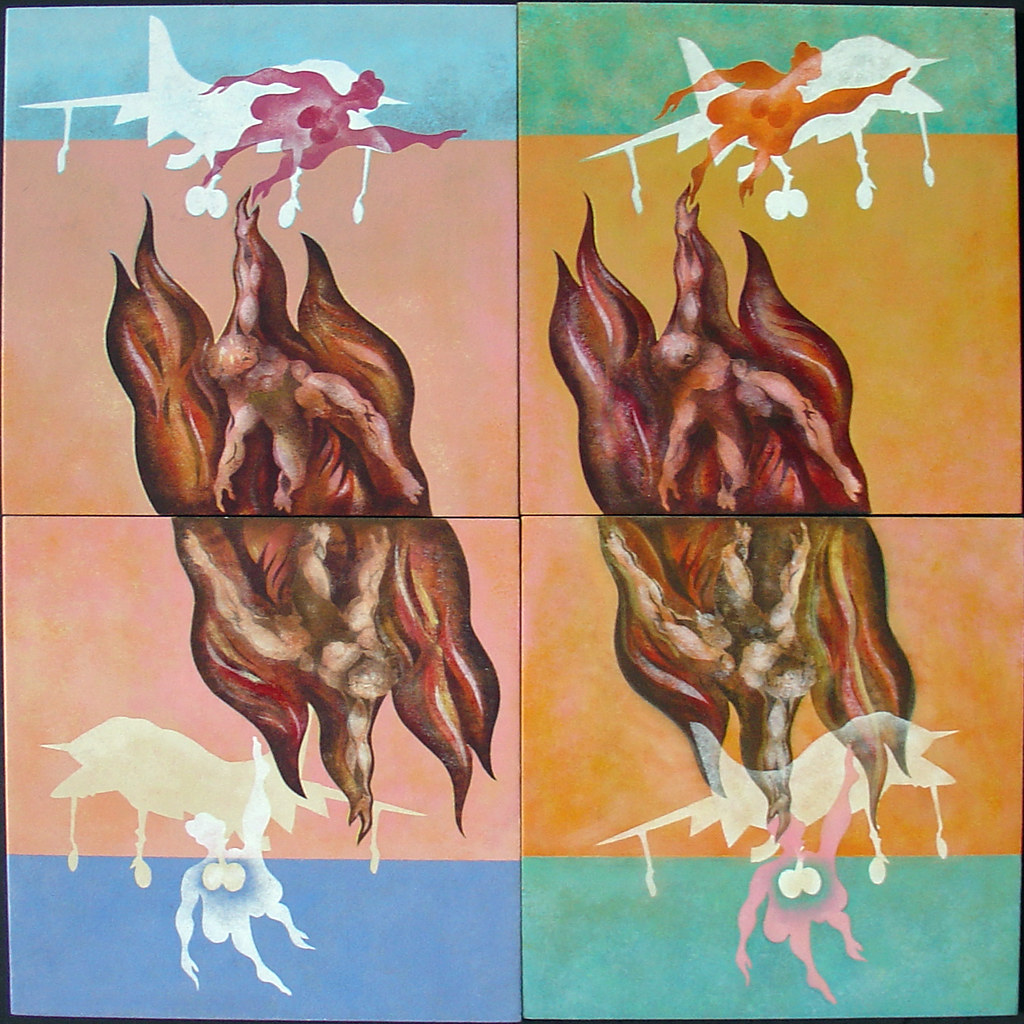
DL: What you were doing sounds like it was more, uh, more related to what was going on around you than what Gratitch was talking about, which was kind of...
BW: Well, which was very specific [unintelligible].
DL: ...which was very specific, timeless Mormon culture, where as you’re dealing with LDS theology rather than the culture...
BW: Well, exactly, yeah...
DL: ...and also the war and contemporary issues.
BW: Yes, but what I have realized, well, for much of my adult life, but more and more, is how I view everything through a Mormon filter. So almost every issue that I encounter is seen through that filter. So whether one deals with issues of good and evil it is Mormon theology that underlies all those questions. It is that theology that leads to the questions, that raises the questions. And then my work has become a way of... it’s really the thinking around the image. And so much of the thought, and the ideas that I arrive at, are never manifest overtly in the work. They are simply, they surround the work. The work becomes a kind of symbol for all of the thinking that the work has provoked, that the work has lead to. It is a way of, the works that I am doing, are ways of raising the issues, but then never resolving them, but only, the issues raised provide an opportunity for more thinking and more work. So I have done a lot of thinking about, well, what should or what might an LDS art look like. And this was an issue when Gratitch was talking about it. He had been talking a good deal with Don Snow, who is LDS, but I think not ever particularly active, and he was not interested in Mormon culture, but he was interested in western, in the western region, and the regional landscape. And I think it was Doug Snow’s view that a Utah artist should be working from Utah subject matter, and for him it was the landscape, and particularly the southern Utah landscape. So it was this kind of notion...
DL: Rather than high mountain pastoral? [both laugh]
BW: Yeah, so it was part of the thinking that if we’re in this time and this place, shouldn’t what we’re working on reflect this time and place. And yet I have never felt particularly tied to the landscape, the western landscape, in the traditional way, in fact I think I have resisted it. But notions of theology and the broader Mormon experience have fascinated me greatly. So let me give a couple of examples of what I mean by this. I mentioned your great great [great] grandmother Lerona Abigail Martin Wilson, and starting as a young girl she had an unusual, a supernatural ability to locate lost objects, a cow would be lost or somebody’s glasses would be lost, and she would sit there, and she would get an image of where it was and tell people, go there and you’ll find it. Then around 1916 she began to have a series of visions, having to with visitations from the dead.
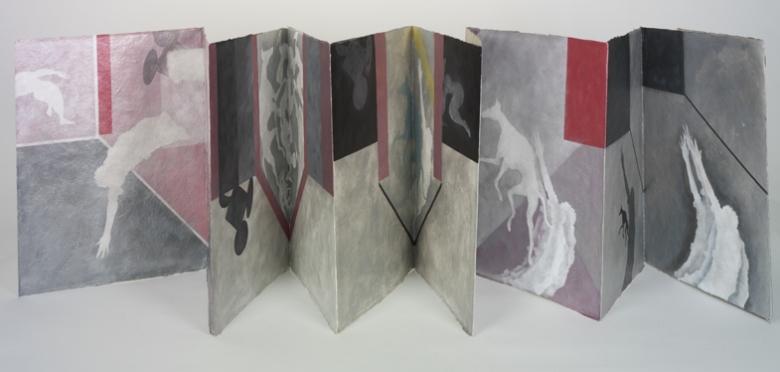
DL: [pointing at drawing] Was this 1916?
BW: Well, yes, but the one where her mother...
DL: This was shortly after her mother’s death, right?
BW: And that, we’d have to look up the dates for sure. The greatest number of visions took place around 1916, but the vision where her deceased mother returned for a visit took place, I think, considerably earlier. But wait, I think there is a way to find out, except there’s some stuff that I need. [long pause] So, um, Ok [****** Dreams and Vis]ions: Life and Experiences of Lerona A. Wilson, circa 1885, I think it is. So this is one of the first [*****] recorded. Her mother was dying of Bright’s disease, and her mother, I think, was only about fifty years old at the time. But they knew that she was going to die, I don’t even know what Bright’s disease was, but obviously there was not a treatment for it. So as the two of them were talking, she was nursing her mother through this last time, her mother said, if I can I will come back and visit you after I’m dead. And this, by the way, would be in line with Lerona’s [***]spiritual gifts. And, so Lerona writes about having an impression during a dream a few weeks after her mother dies that [*******] was trying to contact her. Then she talks, or writes, about a waking dream. In other words, she says that her husband, my great grandfather, had gone to a high-counciler meeting, and she had an older child and twins, and the twins were still nursing. And so she described a rushing sound and the room filling with light, very much like Joseph Smith’s vision of the angel Moroni, and here is her mother who appears to her. And she describes how her mother looks, and she’s healthy, none of the deathly pallor that she had when she was ill. And surprise, her mother was accompanied by a greyhound dog. And she says to her mother, why do you have this dog with you? You never liked dogs when you were alive. And the answer was, well, they help us find our way back if we are lost. Well here in mythology dogs are companions for the dead. And yet, this uneducated woman doesn’t know mythology, and dogs are companions for the dead. But here we see this mythology coming out in her writing. And...
DL: That’s Egyptian, I think that’s also [Chinese *********] [laughs]
BW: Well it certainly is Egyptian, but I think it’s even, it’s broader than that.
DL: Yeah, ‘cause then I think we’ve run into it in [Meso-American mythology *********]
BW: And so I just don’t know how she would have encountered something like that. So it’s one of those just [*******]. Now here the two of them take [*****] through space with the dog leading the way and [******************] describing what the earth looks like [******] outer-space. And they travel to [*******] so then [****] realm and Lerona begins to describe [***] modern section and the ancient section, and she describes her mother’s home, and she describes her mothers job with children [***************] tending flowers [********************] a description that is lucid and beautifully written of what the spirit world is like. Well I have been fascinated by Lerona’s story since... some of my earliest memories are of the family talking about Lerona and Lerona’s visions where she describes other planets being crystal, you could see through them, the sorts of things that are, well, when the earth is to become a Urim and Thummim. Well she was describing these kinds of things. And she always, it wasn’t for her, it wasn’t to gain attention. Just before my father died I interviewed both my mother an father about Lerona. I wish that I had interviewed my grandfather, because he was the eldest son, and I didn’t have the presence of mind, I didn’t have the kind of interest until too late, because I would love to know what he thought. But when I asked my mother, what do you think about Lerona? And she would say, I don’t know, I just can’t believe it. And my father would [****************************************************************************************************************************************************************************************************************************************************************************************] sketchbooks, at least [********************************] visual and [*********************] further than that [******************************] and then[******************] sculpture [********************] I was going to do books, artists books. And so I began to work with Lerona’s visions, became a very, well, appropriate thing to do, because of [************] versions [*****] coupled with images [********] Max Ernst’s [*********]. And as I would show others what I was up to [****] they looked at what I had done [******] stencil [***] and what have you and [*******] they were looking at Max Ernst’s stuff. Which was pretty much of the time, the period of time when Lerona was having her visions. And so I said, well, why not. If that’s what [*****] want to look at I’ll [***************************************************************************************************************************************************************************************************************************************************************************************] that isn’t pioneers, and it isn’t landscape, it isn’t Book of Mormon illustration. It is the Mormon spiritual experience that goes back to the early days of the church, where spiritual manifestations and talking in tongues and so on... if we think of the Kirtland period, for example, at the dedication of the temple. That is a part of the mormon experience, or Latter-day Saint experience, that has been pretty much lost. And I, see, Lerona was carrying it on. At the time that she was writing her experiences she talked about a woman who was a healer, who went with her to help care for her mother. And this woman said, I feel that my mantle, my spiritual gift for healing, will be passed on to you. Well this is a dimension of healing and spirituality that has not to do with the priesthood, but is something deeper and perhaps more broadly distributed...
DL: More to do with spiritual gifts and talents...
BW: ...than the priesthood alone. So this is one of the things that I am attempting to get at in my working with Lerona’s text and imagery that begins to raise all kinds of questions about... Well, in some cases I’ve put big question marks, and what I’m doing in the, as I do Lerona’s text I am marking through her text, well every one that’s become... all those haven’t been finished... but I’m putting a big cross...
DL: On that one...
BW: Well, yeah, except that’s not, they’re over there. Well here let’s [*************************************************************************************] Here is Lerona’s text, and this is about the ancient section of the spirit world, and then the modern section. and I have crossed through...
DL: The text.
BW: ...every piece of, every section of Lerona’s vision.
DL: Great big orange Xs.
BW: Now why have I ex-ed it out? Why have I canceled her text? Well, it’s a way of questioning, in one sense, is what she has written true in the sense of, did she have some sort of spiritual manifestation? I’m not even sure I want to know. But the X is also an indication of, after she had gone to the trouble of writing her life story, and she was actually commanded by a spiritual being, an angel, to write her life story, then your great great [great]grandfather began to be concerned about, well, is she [*****************************] to have these kinds of experiences, because there’s a question of whether she might have stepped over the line in admonishing...she said, this is for family, but she was also writing for women in the church, and was she going beyond what she...
DL: What was the established role for a woman...
BW: Yeah, exactly.
DL: ...in the church.
BW: And...
DL: Let me, let me point out for the people who’ll be listening that don’t know about printmaking, that the X across a plate is a cancelation mark.
BW: Exactly.
DL: I mean, this plate will no longer be printed.
BW: Oh, well, you can print it, but if you print it you know that...
DL: ...it’s not...yeah.
BW: ...it no longer has the approval of the artist, because this cancelation means, that there will be no more prints made from this edition, and I was actually thinking of that when I did it. So our, my great grandfather said, I think we should not publish her life story. So he had, in effect, censored it. So this is a form of censorship, so I say, well I’m just carrying on the tradition of Wilson males, by canceling, or not permitting the text to be known. But you see my X is ironic, because if it’s crossed out you’re not supposed to read it. What do you want to do? You want to look beyond the X to see what’s behind that. So I’m actually using it as a way, at least in my mind, of exciting interest in Lerona’s text. So what I struggle with when I work on this piece is to convey some of the rich imagery of Lerona’s visions, and yet at the same time to not illustrate them. They do get a little bit illustrationy, but I hope not too much.
DL: I mean you’re pulling from... Is that also Max Ernst right there?
BW: Well, this is Max Ernst, and this is, from uh...
DL: And he himself was pulling from a huge history of etchings and...
BW: Well actually from cheap popular novels, but this is from the work of a contemporary architect and city planner, this is Gaudí’s work from Barcelona...
DL: From La Sagrada Familia.
BW: So I pull on all of this stuff as a way of conveying the notion of an ancient section of the spirit world, and a modern section. So what I hope I am doing is moving, at least my contribution to LDS art, into realms that it has not moved in before. Uh, let me give you one other quick example, and that is the piece that I worked on in 2006 getting ready for an exhibition of my work in the Pearl Street Gallery in Brooklyn. And there is a line in my patriarchal blessing that says, because of your faithfulness in the preexistence, you were permitted to be born to parents of your own choosing. And my patriarchal blessing was given to me by my grandfather, Lerona’s oldest son. And he served as patriarch both in the [???], Idaho stake, and also in the the Cache stake, I think it was in Logan.
DL: And this is in the very established male tradition of revelation, [laughing] the “safe” tradition of revelation.
BW: Exactly. Well, from my, I was probably seventeen or so when I received the blessing, and immediately that was the phrase that stood out in my mind more than anything else. Why did I choose these parents? So this last year I took on the task of doing a folio of twenty four pieces that explore that very [file truncated]
Posted by
Dane
at
1:23 AM
0
comments
![]()
Labels: art, artists, family, interviews, Mormonism
12 November 2007
Circle of Life

(If you're squeamish you might want to stop this page before the photos load all the way.)
The circle of life in our house veers in strange ways. Tien, like all cats, love to catch things that are moving fast, like birds, cockroaches, or lizards. I liberate the birds if I can get to them in time, I praise him for the cockroaches, and the lizards, well that used to be problematic, because he never eats them, or at least not all the way. I don't know if I've mentioned our hedgehog Elinor on this blog yet (J has a post on Biciclette about when we took her to school), but she has helped close the loop where lizards are concerned. The other day Tien caught a finger sized skink, Elinor happened to be awake at the time since we'd just fished her out from under the fridge, and I thought, 'Good I'll feed it to her.' By the time I stepped out of the kitchen to help her find it, she was already munching away. I think she could smell the blood.


Posted by
Dane
at
1:10 AM
0
comments
![]()
09 November 2007
Project Deseret
 Jami and I are big fans of the Mormon Stories podcast and are thrilled that John Dehlin has been posting content so regularly during the past few months. Back when John was trying to decide if he should continue the podcast, and had issued an open call for submissions, I even went so far as to interview my own grandfather. Unfortunately the sound quality was miserable, though I hope to repeat the interview next time I'm in the States, since my grandfather is a pretty fascinating guy , a lifelong educator in the arts, and his recent work is about his great grandmother's visions. I was also anxious for Mormon Stories to make good on its pledge to discuss the arts, which, looking back over the feed, has only been lightly touched on in the podcasts about Deseret Books' acquisition of Seagull Book and Tape and Covenant Communications, particularly the interview with Ken Larsen of the Mormon Artists Group (a group to which my friends Annie and Kah Leong Poon belong, lucky New Yorkers). Well it's been nearly two years (I see 30 Dec 2005 as the date for the original Kiddie Baps episode) and Mormon Stories finally has a podcast about art on its feed, sure it's somebody else's podcast, but hooray anyway. Ashley Sanders, primary organizer of Alternative Commencement at BYU, has initiated the Project Deseret Podcast, a sort of Mormon-flavored This American Life (this is what my friend Trent was trying to do with Moderates Among Us, but then he and his wife had a kid, and he "pod-faded" after only two episodes). The format of the inaugural episode is somewhere between TAL and Mormon Stories itself, minus the obligatory back-story from the interviewees. We'll see how the project develops, but thus far the content is excellent even though the technical execution could use some polish (hey, I understand, that's why no interview with Brent Wilson has graced the bloggernacle yet).
Jami and I are big fans of the Mormon Stories podcast and are thrilled that John Dehlin has been posting content so regularly during the past few months. Back when John was trying to decide if he should continue the podcast, and had issued an open call for submissions, I even went so far as to interview my own grandfather. Unfortunately the sound quality was miserable, though I hope to repeat the interview next time I'm in the States, since my grandfather is a pretty fascinating guy , a lifelong educator in the arts, and his recent work is about his great grandmother's visions. I was also anxious for Mormon Stories to make good on its pledge to discuss the arts, which, looking back over the feed, has only been lightly touched on in the podcasts about Deseret Books' acquisition of Seagull Book and Tape and Covenant Communications, particularly the interview with Ken Larsen of the Mormon Artists Group (a group to which my friends Annie and Kah Leong Poon belong, lucky New Yorkers). Well it's been nearly two years (I see 30 Dec 2005 as the date for the original Kiddie Baps episode) and Mormon Stories finally has a podcast about art on its feed, sure it's somebody else's podcast, but hooray anyway. Ashley Sanders, primary organizer of Alternative Commencement at BYU, has initiated the Project Deseret Podcast, a sort of Mormon-flavored This American Life (this is what my friend Trent was trying to do with Moderates Among Us, but then he and his wife had a kid, and he "pod-faded" after only two episodes). The format of the inaugural episode is somewhere between TAL and Mormon Stories itself, minus the obligatory back-story from the interviewees. We'll see how the project develops, but thus far the content is excellent even though the technical execution could use some polish (hey, I understand, that's why no interview with Brent Wilson has graced the bloggernacle yet).After a TAL style story about Mormon Jesus-kitsch the bulk of the podcast is an hour-long interview with BYU humanities professor George Handley. I found myself nodding my assent to the discussion, the careful treatment of quotes by general authorities regarding the arts and artists, Handley's admonition that we should engage the world, his radically expanded notion of tradition, his desire to divorce Mormon culture from American culture and commercialism, until the near the end of the interview, where he gives a disappointing list of what he seems to think are exciting projects for a young LDS artist:
...I alluded to T.S. Eliot earlier, and I am not remembering the title of one of my favorite poems by him, but he talks about building the kingdom of God is just as much the work of a poet as it is a stone mason, and that we should remember that we have that responsibility and that opportunity, and that kind of art that maybe is less identified as immediately useful to the building of the kingdom in terms of crafts and building buildings and so on, but writing poems and painting paintings that aren't necessarily going on murals in temples, or whatever, but if you're painting an individual portrait, or painting a landscape, or writing a poem about an experience in the mountains, or writing a novel about day to day living in Utah Valley, whatever it might be, that too is building a sensibility and building a world orientation that is extremely important. So I guess it's just to underscore the fundamental importance that president Kimball gave to the arts that I don't think has been revoked by anybody since...
A portrait, a landscape, a poem about the mountains, a novel about Utah Valley (Terry Tempest Williams anyone? No wait, she's good!). Are these really the important projects somehow left outstanding and untouched after generations of LDS artists? When the murals for the Salt Lake Temple were being prepared the church sent a group of artists to study in Paris, the epicenter of the art world at that time. Instead of returning to Utah as careful and accomplished academic painters, the most conservative course available to them, they came back as Impressionists, firmly planted in the movement that stood on the brink of the radical transformation of art that would be Modernism. They were not afraid of engaging with the artistic avant-garde of the day, and they understood that the centrality of light in the Impressionist project resonated with the centrality of light and truth in LDS doctrine. Over 100 years later Impressionism has ossified and become a benchmark of conservatism and all-round fuddy-duddyness, so it might be difficult to understand how radical it once was. In contemporary terms, this would be as though President Hinkley had sent artists to study at UCLA, SVA, Yale, or Columbia, where they would learn from the likes of Mike Kelly and Kara Walker. Ooh! Imagine that, a Mormon Kara Walker making prints for our temple waiting rooms and chapels. The sad fact is that as Mormons we ignore our best artists, those that chose to take on the contemporary art world on its own terms, rather than pander to the kitschy sensibility of a church culture that confuses a political party for a priesthood auxiliary organization, and cloying sentimentality for high art.
I'm probably being too harsh with Handley. Like I said, I agreed with most of his points, but the the fact that his list of artistic projects that could help build the kingdom was so uninteresting made me wonder if he'd been serious after all. He is a writer, and writers like things with a history they can contextualise, and a narrative that makes sense. Historically artists have made their fair share of portraits and landscapes, and they continue to do so in the present day, so it's fair enough to characterize their endeavors in those terms. But the fact that an LDS writer and professor of the humanities, someone engaged in advocating and defending the arts in an LDS context, has such a narrow view of the visual arts, and such uninteresting ideas about writing is discouraging (where's our Nabokov? where's our Borges? to lament past greats). This is why when I tell church members that I'm a sculptor their next question is what material I use, and why when I answer, "plants, food, plywood, hair, my own body (to name a few)," I usually elicit a blank stare. How can artists talk to the rest of the church in a meaningful way if we don't even understand one another's projects in terms that make sense? So I hope that as Mormon Stories and Project Deseret continue their discussion of the arts in the Church it will expands the listenership's notions of what contemporary art actually is rather than relying on outdated notions of how artists work.
Posted by
Dane
at
6:16 AM
2
comments
![]()
07 November 2007
05 November 2007
Sewer Mold
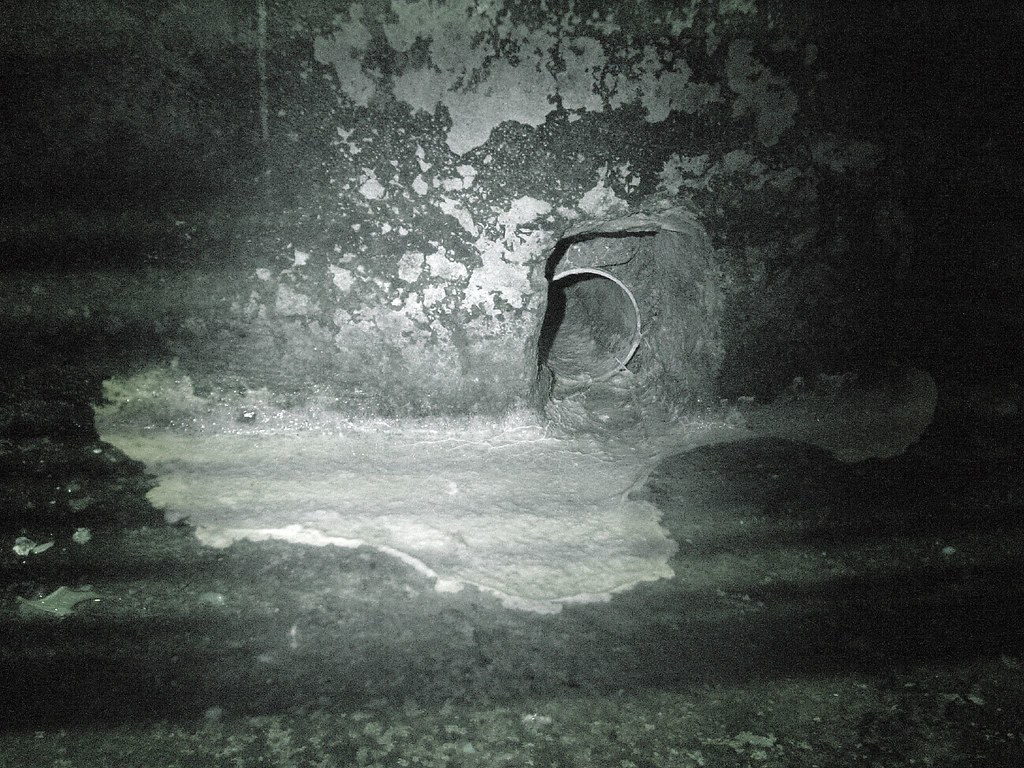
About once a month this crazy orange mold creeps out of our drain from the sewage ditch.I think it's kind of pretty. It grows fast, cover half of the sink's nether regions in about a day. You can sort of see the color below.
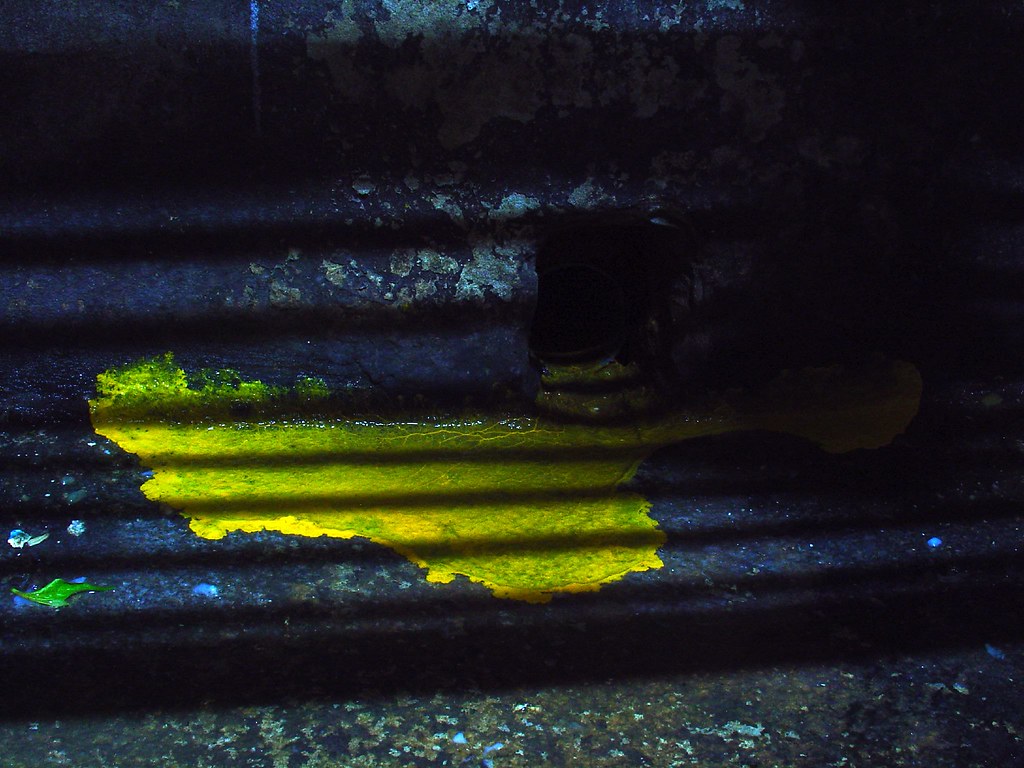
Posted by
Dane
at
12:15 AM
0
comments
![]()
04 November 2007
Lao Again

Last week we made our ante-penultimate visa run to Vientiane. We arrived on a Saturday during a boat race festival on the Mae Kong. I think it was something like the Lao version of Loy Krathong, because the river was full of krathongs, and longboats made of bamboo and banana trunks were set up in front of people's houses and businesses.
The trip was plenty boring, primarily since we don't drink. At least that's how it was explained to us afterwards when we were complaining to friends that there's nothing to do there, and wondering why there seem to be so many tourists regardless of the fact. The highlight, as usual, was the food. Chiang Mai doesn't have any decent Vietnamese food, so that's about all we eat in Lao, that and baguettes with salami.
Since we got back the weather has changed dramatically. It's cool and unseasonably rainy, a bit like Texas in the fall, making us feel muito saudade. We're enjoying the cool weather while it lasts, and chuckling as the Thai run around in quilted coats, sweaters, worrying about their health.

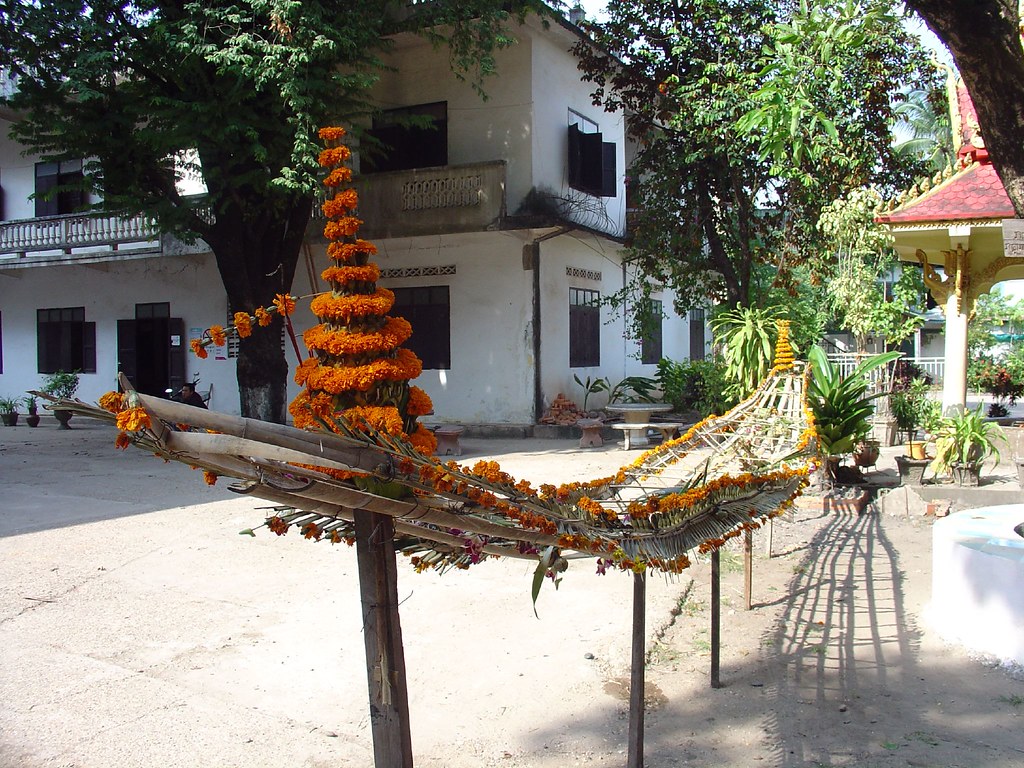
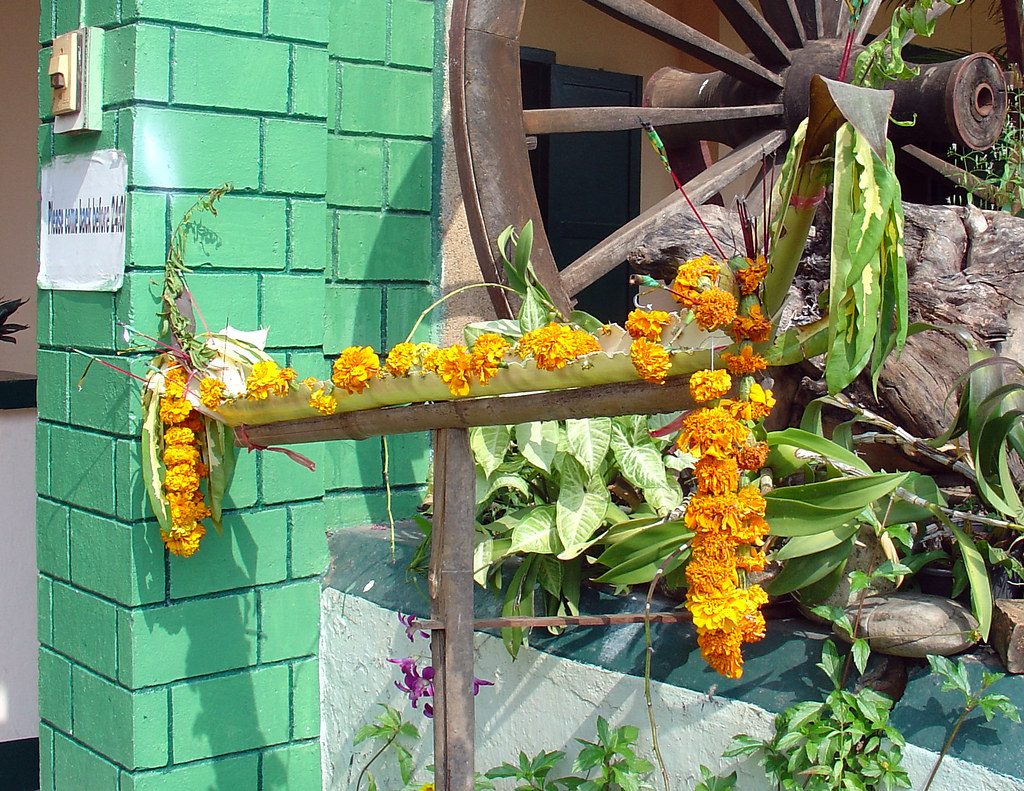


Posted by
Dane
at
11:19 PM
0
comments
![]()
01 November 2007
31 October 2007
21 October 2007
The Neighborhood

Posted by
Dane
at
10:27 AM
0
comments
![]()
Labels: Chiang Mai, living, Thailand
16 October 2007
About Oil
 Since the war in Iraq began, oh so many years ago, I have often heard it asserted that this was, ultimately, a war about oil. I assumed that meant that this was an imperialist grab for Iraq’s oil resources, which, considering how things have turned out thus far, was a remarkably stupid move.
Since the war in Iraq began, oh so many years ago, I have often heard it asserted that this was, ultimately, a war about oil. I assumed that meant that this was an imperialist grab for Iraq’s oil resources, which, considering how things have turned out thus far, was a remarkably stupid move.The other day I was talking to a friend, a technical consultant, in the oil business, and I asked him, about as incoherently as possible, what he thought of peak oil. He told me that throughout his career he had been spec'ing and subsequently shelving hundreds of small projects that were just too expensive to do—they all required $80 a barrel oil in order to be profitable. Now that prices have reached $80 a barrel, all those little projects are coming off the shelf. So yes, he did believe in peak oil, and watching all those expensive projects finally pop into existence was proof enough for him. He believes we will always have a petrochemical industry, but that soon we’ll be hitting ourselves over he head for doing stupid things like turning natural gas into fertilizer. I thought that was a good point since natural gas becomes irrecoverable after being turned into corn and algae.
Later on, the next day or so, I was listening to some of the dire predictions about the consequences of a war with Iran, including $100 a barrel oil. That lead me to the following, rather sinister conclusion: what if the war in Iraq, rather than being a bungled attempt to appropriate Iraqi oil, is a actually a brilliant scheme to keep some Middle-Eastern oil off the market for a while, raise the price of oil over all, thereby generating revenue to develop projects that would previously have been unprofitable. I’m sure this has occurred to someone somewhere already, and Mark L. could probably tell me exactly why I’m wrong, but the thought seemed novel enough that I thought it worth publishing to my glorious audience of three and a half people.
24 October 2007
True to form, ML knows exactly why I'm wrong. Here's what he has to say:
Dane,
I am glad to see that your blog is back up and running. I also appreciate the "shout out".
I don't know why we went to war with Iraq, but I wish the Bush administration had used oil as a justification. I think Bush had a strong desire to invade Iraq, so he looked for intelligence that would enable him to realize his dream. I guess he sort of data mined intelligence to support a war. Data mining in research generally produces flawed results and Bush showed that data mining in foreign policy produces equally erroneous results. I know I voted for George Bush and before we invaded Iraq I told everyone, probably you as well, we should just invade Iraq now because Bush is going to do it anyways. I think I was right.
There is a great justification for the invasion had the war been about oil (Al Greenspan revealed the justification in his new book). Before the invasion, Saddam was trying to control of the Strait of Hormuz and as a consequence of that, a huge portion of the world oil market. About 20% of the world's oil supply is shipped through the straight and had Saddam stopped shipments, the price would have most definitely sky rocketed. People around the world would suffer extreme economic and physical hardships. Can you imagine the world-wide hardships created by another depression in the United States? I know the atrocities of the war in Iraq are absolutely deplorable, but the alternative is far worse.
On as side note, I really believe the diversification and interconnection of the US and world economies make the US economy some what depression proof to anything but a large and sustained spike in energy prices, specifically crude oil.
I disagree with any assertion that the Iraq war is about stealing natural resources. Most undeveloped countries have strict production sharing agreements with large oil corporations that are very favorable to the undeveloped countries. Oil companies almost act as consultants and get a percent of the revenues from the production. Without the oil companies, the undeveloped nations would never be able to realize the value out of their reserve base that is technically feasible because they lack the expertise. Venezuela is a great example of why undeveloped nations need large oil companies. Production in Venezuela has dropped off significantly over the past several years as Chavez has moved to nationalize all oil and gas assets. Venezuela might be getting 100% of a 100 Million barrels of oil produced a year, but that number will decline and it is much less than the 50% of 500 million barrels of oil they could receive (I made those numbers up. I know production has fallen off to the point where the example applies, but I am not aware of the actual numbers). Any oil contract that a large oil company receives in Iraq will benefit the Iraqis much more then if they tried to develop their own fields. They will never have the expertise of an exxon mobile. It is a good socialist rallying cry, but is highly illogical from an economic stand point.
I also disagree with your notion that the US invaded iraq to remove its oil from the market and artificially inflate prices. You obviously understand the economics of oil. It is a world-wide traded commodity that is priced almost exclusively based on supply and demand. Macro issues in any nation around the world have little bearing on the actual price of oil (ie, inflation in the US does not affect the price of oil like it would the price of a car. Inflation would only affect the price of oil if it affected demand or supply). When politicians speak of charging oil and gas companies a windfall tax because americans feel that oil companies are gouging consumers, I usually get sick to my stomach thinking about how imbecilic the leaders of our nation are. Most of Iraq's oil production was offline at the time of the full scale invasion of Iraq. Iraqi oil entered the market through the UN oil for food program and black market activities, but Iraq did not have the technical expertise required to realize a significant level of production. If anything, the Bush administration believed that oil production in Iraq would increase shortly after the invasion, which would decrease the price of oil. Large oil companies would be able to enter the country, develop their oil fields, and bring production back online. If you recall, many of the budget projects for the Iraq war assumed that the government would be able to fund itself shortly after the war because of increased oil production. Obviously the instability in the country has prevented any effort to increase production.
I do not think the US is motivated by oil to invade Iran. Iran is a destabilizing force in the dead sea region and has caused the death of many innocent iraqis and americans. Iran also has the stated objective of wiping out one of the US' most important allies. Maybe I am drinking bush's Kool-Aide, but I believe any attack on Iran will be based on saving innocent lives.
On a side note, if you are interested in the concept of peak oil, I suggest you check out a book by Matthew Simmons called "Twilight in the Desert".
Simmons is LDS (his family owns Zions Nation Bank) and has an investment bank in Houston named after him.
I enjoyed your post and hope you keep writing. Sorry if my email was a little windy, I didn't have enough time to chop it down.
Regards,
Mark
And I had this to say:
Mark-
I knew you'd set me straight, though I hope I made it clear that the notion that the war is about stealing resources is not my idea, just a distillation of what I think people mean when they say, "yeah, it's all about oil, man." I think Bush took us to Iraq because he imagined it was his destiny, the data mining and phantom WMDs were just to justify what he would do no matter what--like you said.
Do you really think the Strait of Hormuz was actually in that much danger? I can't imagine Iran, the U.A.E, or Oman would have let it happen. And if Saddam had made a military move on the strait, well, we would have had a real reason to attack, an actual objective, like the liberation of Kuwait. The administration's justifications for the war seem to change monthly, and I am left with the suspicion that Bush's willingness to jump in there was an easy cover for something else. Personally I couldn't have been happier if the NeoCons had been right, and Iraq was booming right now. We wouldn't be breathing down Iran's neck, they might not have elected that idiot Ahmadinejad (we had a lot of support there after 9/11, all of which we've squandered in Iraq), we might have had the resources to finish off Al Qaeda properly, and who knows what else. But I suspect that someone was going to be pleased no matter how things worked out, and that even the mess we are in now is working to someone's advantage.
Of course I realize the price of oil has to do with increased demand (China, India, everybody else), but markets also responds to perceived threats to supply, like a destabilized middle-east. Naturally I have no proof, but I can imagine someone devious enough to manipulate the perception of risk. The fact that Iraq was largely off-line only convinces me more, since its continued absence doesn't effect actual supply, while violence in the region reinforces the notion of risk to continued production. And facts are facts, even if none of the major decision makers going into the war were hoping that oil prices would quadruple for the sake of further exploration, the current prices are having that effect, allowing companies to access smaller and deeper deposits.
So now that we are seeing a sustained spike in oil prices (the predicted outcome of Saddam grabbing the Strait of Hormuz, and, by the way, wouldn't a pissed off Iran be more of a threat to that particular bit of geography?), what happens? I see that predictions a year from now have the price at over $100 bbl. Does that mean we get a depression, or will it take more than that? Personally, I welcome high oil prices. It means more r&d will go into alternative, hopefully sustainable, energy sources. And if we stumble a little as a result, well, sucks for us, but I don't think the outcome will be as devastating as we imagine for the rest of the world (J and I will just move to France or something like that). Means of production are much more equitably distributed than they used to be, so I don't think things slowing down a bit would automatically plunge us into a dark age. Some countries might actually benefit from a more hands-off policy on our part, allowing them to trade more with each other, creating a more robust network in the long term.
I'll look for that book when I'm back in the States and earning dollars again (they're better than Baht, even if they are worth less than loonies now). And thanks for making me rethink my groundless assertion. Do you mind if I add the text of your email to that post? I enjoyed it.
How's your art collection coming?
Posted by
Dane
at
11:10 PM
3
comments
![]()
Biciclette

Jami has started her very own craft blog. So far it is full of cute clothes and cute Tien dolls. Enjoy!
Posted by
Dane
at
1:18 AM
0
comments
![]()
06 October 2007
Notes to Lawrence Weiner

Not to give Dave Hickey's libertarian capitalist view of the art world pride of place, here are my notes to a talk by Lawrence Weiner, whose "materialism" we might fairly read as "historical materialism" (hey the guy used to be muscle for NYC labor unions).
*Note for readers sensitive to the F@(< word, I don't use it in this blog, but I don't censor it here.
Lawrence Weiner
notes from talk given 10 October 2001
The world is a very big place, and the only way to get there is to travel.
art is not a metaphor, art is an empirical reality
metaphorical art carries a structure with it not allowing others to have an immediate experience with materials.
ended up in high-schools w/professors victimized by McCarthy
Pollock & Giacometti; much prettier and nicer girls at art museums
get out. if you do alright you don’t have to get a degree (18 yrs old 1st show in San Fran)
language takes away the authority of the artists hand [la pata]
sculptor not conceptualist because he’s a materialist not an idealist
“Art that does not allow itself to be used by another culture is telling you…that ethics is aesthetics…that someone who doesn’t look like your mother is not human.”
site specificity is “kinky”
not just for you and our own set. Change the whole order
“If you’re lucky you won’t fuck up somebody’s day on their way to work. You’ll fuck up their whole life.”
“Does every stone have a place in the sun & do you believe where they tell you it belongs?”
“I can’t stand artists who don’t screw up sometimes, it means they’ve got a system.”
phony’s inherently evil
“I see art as useful as shoes.”
“Oh, but Lawrence, art is for rich people, and women.”
Posted by
Dane
at
3:26 AM
0
comments
![]()
Notes to Dave Hickey
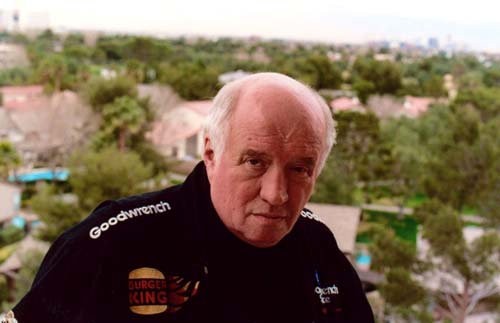
I was looking through a few old sketchbooks the other day and came across these notes I'd taken at lectures given by Dave Hickey. I've actually photocopied these notes for people before, so they've been of some value to me, and others. In transcribing them I've attempted to follow my rather idiosyncratic mode of note taking--arrows, wacky lines and all.
Dallas Museum of Art
16 November 1998
not what causes art, but the consequences
Edward Ruscha “Well, I may be misinterpreting it myself.”
Art & writing—creates the occasion for argument about what [the artwork] might have meant
each era gets the art world it deserves
brings us together so we can sort ourselves out
a-historical culture—no change in A[rt]
revolutionary culture—change in A[rt]
change from an iconic to a representative art
from presence to likeness→stands for absence
embodied meaning—relationship of one sign to things like it
designative meaning—word refers to something unlike it
icon—presence, incarnation
image—likeness
real art world (ours) begins in the 16th century
Salvatore & Guido—Raphael and Michelangelo
Sal: I like the Raphael better
Guido: How can you like it better? Michelangelo is from an old family. Raphael is a street kid.
Discourse begins, has nothing to do with what paintings mean, has to do with economic conditions
Idiosyncratic Styles
↓
commercial competitiveness
distinct styles embody identical info
Sal likes that object best. Meaning is unimportant.
[the artwork is] invested w/ secular grace by the beholder
developed constituencies of people who talked about vaina
before the discourse was before [in front of] the work of art
“Did you see Fra. Angelico’s angels? Totally bitchin’, there’s some stuff there I can steal.”
years later:
“Couldn’t we replace this?”
1 individual person saying “we’ll keep it, we’ll preserve it.”
do we like it? is it worth saving?
that is how works are preserved.
Botticelli stuck in the basement
pre-Raphaelites bring it out
has to do with how works of art are invested with value from without
[works of art] have no intrinsic value
meanings come from without
If we like how something looks, but not what it means,
so we change what it means
oil glaze—to represent the incarnate word
later: look at the realism, [the] divine humanism of [the] Renaissance
look at the push-pull
crack it up with another meaning
paintings have no meaning
What are we arguing about?
we’re arguing about what we belive in, what we desire
communities of desire
object serve as locus of external endowments of value and meaning
Libby [Lumpkin] “we artist historians study how objects look, physicists study objects.
we ascribe meaning”
Warhol:
the interesting thing about the present moment is not that art is becoming more commercial, but that the commercial is becoming more artistic. the president drinks Coke, I drink Coke, if the Queen of England wants a Coke, it has to be a Coke, ‘cause nothing else will do.
democracy of objects
a world of originals infinitely dispersed
hard for Europeans; deeply hierarchical
meaning displaced—irony—vertical repression
we [Americans] can’t do irony,
we do cool
↓
[effortlessly] asserting yourself among peers
being who you are and not making a big deal of it
George Washington—talk about what he did
cool is an idea of incarnation
Monica Vitti—premodern creator
embodying something but not insisting upon it
all these diverse Americans:
people talk about their Ford
discourse of icons that hold the country together & help us sort ourselves out
discourse of value
world he grew up into [there were] Stones people & Beatles people, George Clinton people & Motown people
non-exclusive communities
It didn’t matter what Mick meant or what Lennon meant, it was the discourse that mattered
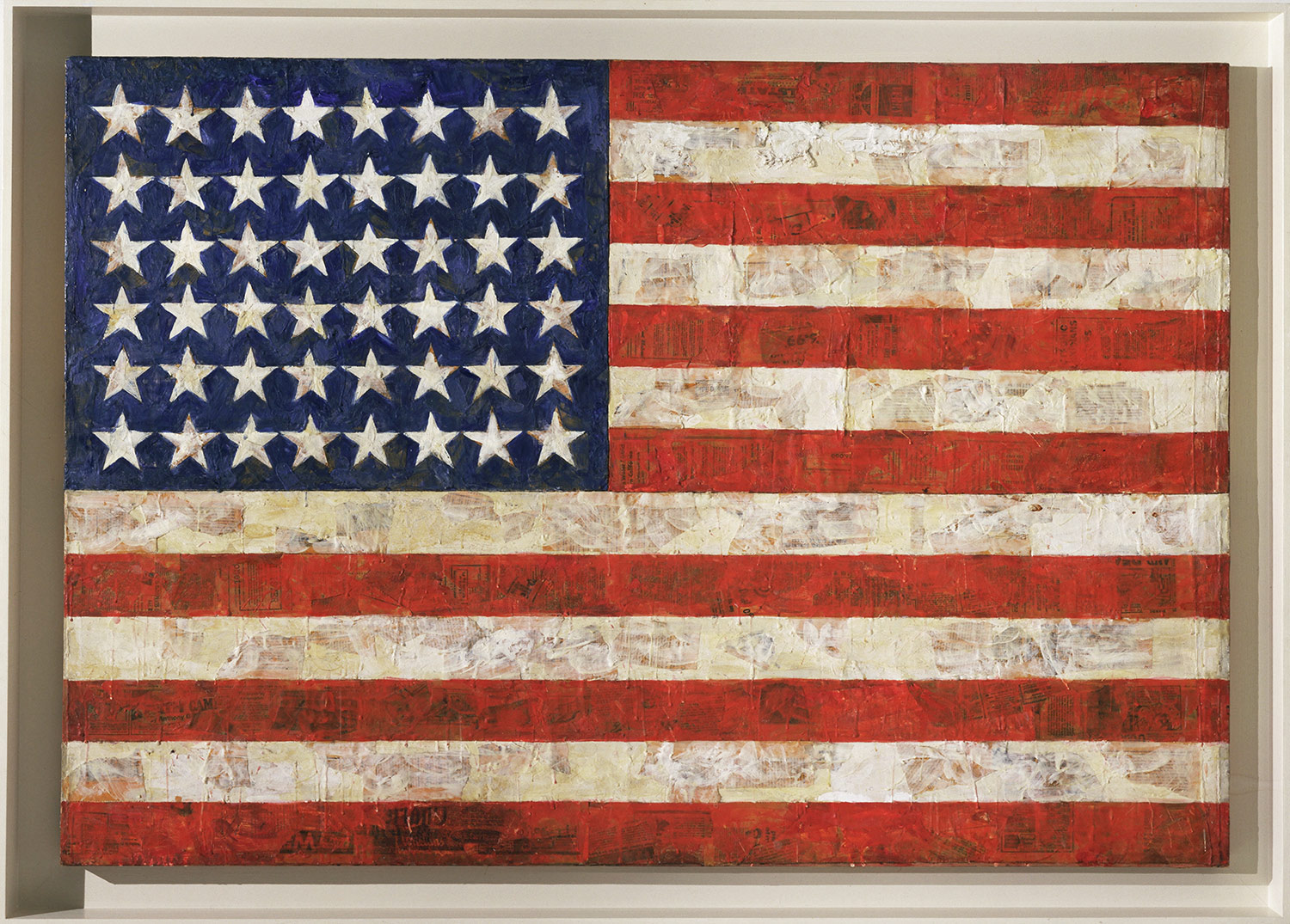 Jasper Johns—first to understand that meaning and value come from with out:
Jasper Johns—first to understand that meaning and value come from with out:
flag—what matters is who salutes it
when the talk stops the object stops being art & becomes an artifact, unless it’s rescued
what’s the difference between The Simpsons and Frank Sellar(?)?
the audience
Whole genres can move from high to low or low to high
“high” art causes writing instead of talk
demonizes writing:
institutional and bureaucratic discourse
metaphysics of presence
painting and sculpture function like a high popular art, like jazz
[there is] art that causes writing and art that causes talk.
writing is there to control the talk.
writing wins because the talk goes away.
you don’t look at Las Meninas and say “wow, I think I’ll go home and write something about it.”
writing→creation→talk→writing→creation
Peter Saul—“It’s hard to keep them ugly. My goal is to come back 50 years after I’m dead and find two people standing in front of my paintings screaming at each other.”
things that survive:
raw information
less privative/reductive survives
reductive force=Donald Judd
[the] first time you like a work of art you Love what it doesn’t do.
This is great; this young woman is not doing anything I hate.
but the stuff that lasts has other qualities.
that which survives is that which allows itself to reallegorization
reductive art doesn’t have the staying power
at first you like it ‘cause it’s fresh (Marylin)
discourse is about “conflict of interest.”
there is no disinterested position from which to see the world.
90% poll watchers and 10% voters
If everyone in the art world works for it disinterestedly, what’s to be bought & sold or done?
Duchamp—artist as liberal artist
greek
arts of the mind versus arts of the hand
Johns [&] Warhol:
carefully aimed at subverting the discourse
If three people unrelated to the artist don’t call it art, I don’t think it is
what—
with the current art world we deal with things with the attention span of AM radio
over heard talking to Vernon Fisher before [the talk]:
“…and what it’s done is it’s created a whole generation of students who think that painting is pinko.”
Blanton 20th Century Series
1 November 2001
Beaux-Arts tradition
↓
“single source” tradition
↓
way of looking at art that disregards the intentions of the artist
↓
artworks: occasions for creating new communities
↓
competing ataliers (subcontractors) unique styles
↓
repeats Guido and Salvatore story
↓
embodiment of values
not talking about content, but composition & XXXX ‘
↓
“this is art”—look at this in the context of all the other art objects you’ve seen
↓
we don’t study objects,
physicists study objects.
we study the way objects look.
[Libby Lumpkin again]
↓
representation of constituency
embodiment of values
↓
Works do not have “content”
they are not containers.
they have a subject in a grammatical sense.
↓
subject vs. attribute
which is which
↓
roots & occasions of abstract art in [the] U.S.
↓
(Philip Fisher, Still the New World)
↓
Europe=specificity
↓
USA=blandness, assimilation, generalization
↓
20s identity politics
↓
Germanic retribalization
tribal feudalism
(tribal cultural identity)
↓
early 20th century
“people could have their own culture & stay the hell out of ours”
↓
reaction [coupled with assimilation]
↓
(generalization & abstraction)
hearths about which the country could gather
(Rothko)
↓
election (constituency)
(we elect abstract presidents, why not abstract art?)
“We will root out the evil ones who hide.”
What the hell? Is this George Bush and the Goblet of Fire?
↓
American artists as redeemed commercial illustrators
synthetic nature of painting
(a Rothko is always a hearth or a landscape)
(de Kooning, pictorial) (Pollock, dance of the artist)
objective correlatives in a public discourse of value
(all about the people in front of the painting, not the ones behind them)
writing & language in nonlinguistic aspects: process, image
a painting with a painting over it with another painting painting it out
occassions for discourse
could you imagine a misinterpretation for these paintings?
David Reed
freedom dramatized and designed.
art presented as expression of community
usually exclusive
(has anyone ever used “community” as a permissive term?)
Abstraction—
statistical generalization of a complex culture
redemptive
what wins never wins for long
the only works that live are those that are defined as beautiful or ugly.
we don’t notice/see what’s in between: the normative
“If we’re not self interested we’re dead, or soon will be.”
“nothing is profoundly what we want it to be”
give absence presence
the idea of the artist is a fiction we create to talk about the works.
Biography is embodiment of critical attitude
“Ed, how can you stand that everybody misinterprets your art?”
“Hey, I may be misinterpreting it myself.”
“the marketplace”
a place where people like art more than money
Mediterranean [culture] vs. Germanic [culture]
Posted by
Dane
at
12:39 AM
0
comments
![]()
Labels: art, critcism, sketchbooks





